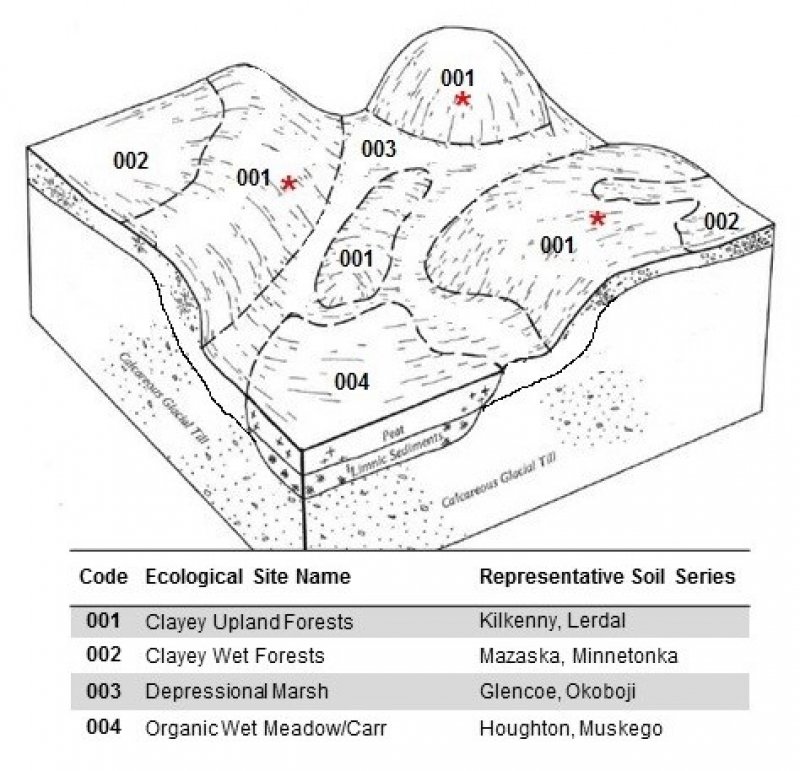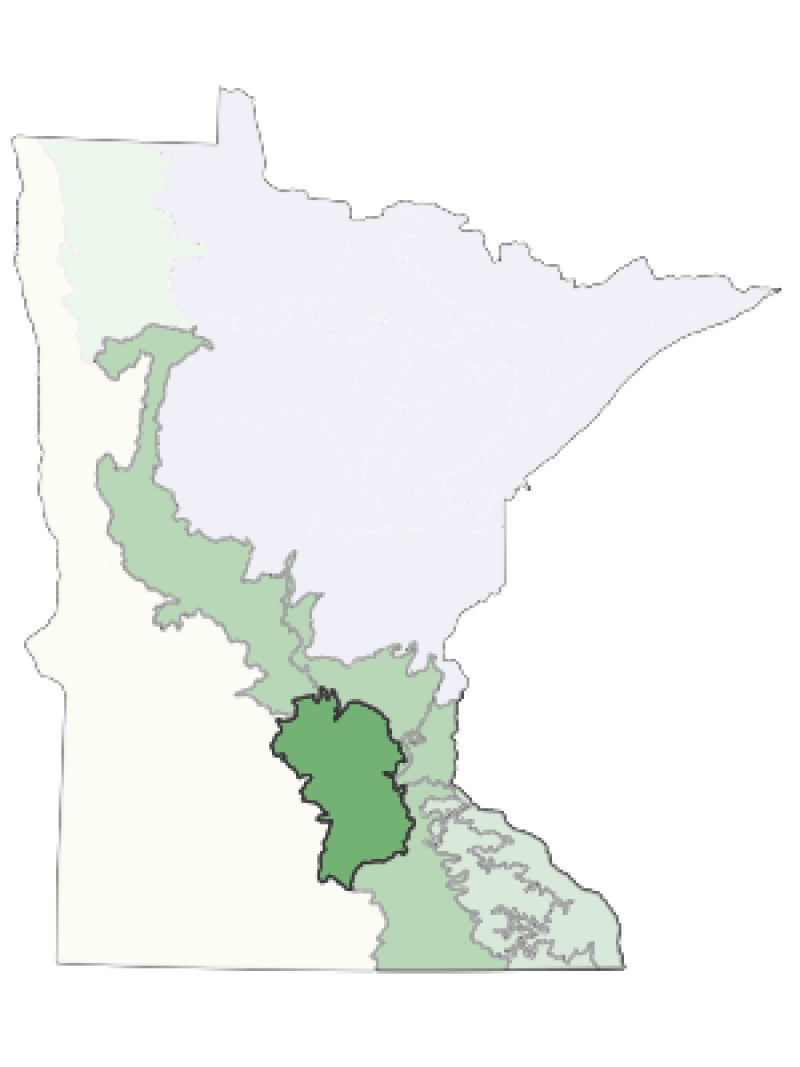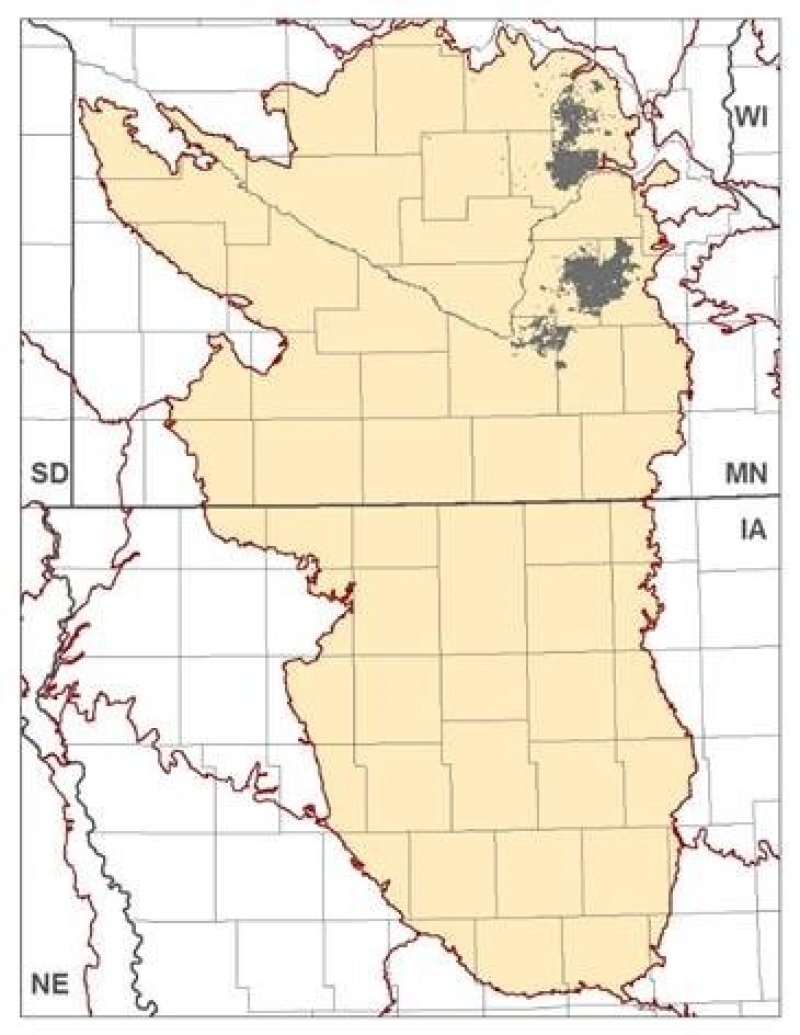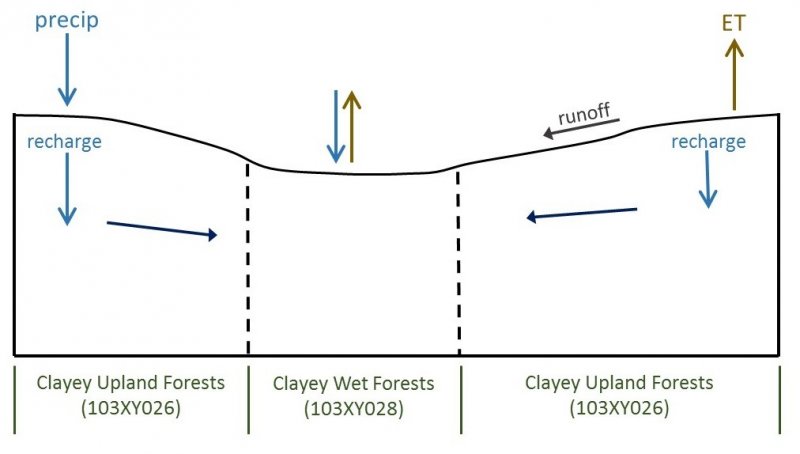Ecological dynamics
The Clayey Upland Forests ecological site is generally confined to the eastern and northern parts of MLRA 103 which includes the Big Woods ecoregion. Wildfires were historically suppressed in this region due to the topography and density of waterbodies. This ecological site currently has three states in the model: the Reference State, the Tillage State, and the Disturbed Forest State.
The Reference State is a mature, deciduous forest with multiple co-dominant canopy species including sugar maple and basswood. This is a relatively stable community in the absence of large-scale natural or anthropological disturbance. Small-gap disturbances occur and result in a series of successional communities. Early successional communities include quaking aspen, sugar maple, and American elm. Mid successional communities are often dominated by sugar maple and American elm. This ecological site can be affected by multiple natural triggers (disturbance processes) including wildfire, drought, insects, and windstorms.
The Tillage State is characterized by tillage and agricultural crop production. The two communities under this state are the Row Crop Community and the Seeded Grassland Community. Management inputs include preparing the site, seeding, fertilizing, controlling weeds and brush, and harvesting. This state is appropriate for lower slopes only.
The Disturbed Forest State is a wooded site that has undergone plant community changes due to human disturbances. Triggers include tree removal, invasive plants, and unmanaged grazing. These sites are dominated by various hardwoods along with invasive species, and do not have the ecological stability or native plant diversity of a reference state. The most common triggers are timber harvest or clearing the site for agricultural production (lower slopes only). Once a reference state has been transitioned to a tillage field, the reversibility class is irreversible.
State 1
Reference State
The Clayey Upland Forests Reference State is a mature deciduous forest. Dominant canopy species include sugar maple and basswood. Common shrubs include hophornbeam and chokecherry.
Resilience management. Resilience management practices include monitoring for invasive vegetation, applying herbicides as needed, and excluding grazing and logging.
Community 1.1
Reference Community
The Reference Community is characterized by multiple co-dominant canopy species, a variable shrub layer, and a diverse ground cover of native herbaceous species. Community composition will exhibit variations depending on slope, aspect, and available water capacity. Typical canopy species include sugar maple and basswood. The shrub layer density is variable, with chokecherry and hophornbeam common.
Resilience management. Resilience management practices include monitoring for invasive vegetation, applying weed control methods as needed, and excluding disturbances such as grazing.
State 2
Tillage State
The Tillage State contains the Row Crop Community and the Seeded Grassland Community. This state describes areas currently in crop production or areas that were tilled but now are seeded to grass. Pathway mechanisms include preparing the site, planting desired species, applying herbicide, applying fertilizer, and harvesting. Hydrological modifications (tiling and ditching) are often installed to improve drainage. Soil tillage is the primary trigger to State 2. Tillage alters dynamic soil properties, including bulk density, structure, organic carbon content, and saturated hydraulic conductivity. Intensive tillage negatively impacts soil ecological functions. Conservation practices can help mediate these soil health impacts.
Conservation tillage minimizes soil disturbance and improves soil structure and soil health. A cover crop rotation builds soil structure, improves infiltration rates, reduces runoff and erosion, and protects water quality. Higher sloping areas within this ecological site are not appropriate for row crop production. When the slope gradient exceeds 20 percent, row crop production is unfeasible due to the farm machinery limitations.
Some areas within this ecological site have been converted to a warm-season grasses. This can occur under conservation programs such as the NRCS Conservation Reserve Program (CRP). Common species include big bluestem, switchgrass, and Indiangrass. Plantings include perennial native forbs to benefit wildlife and pollinators. Non-native, cool-season grasses are also feasible. Seed mix selection will depend on landowner goals and objectives. Seeded grasslands are not as species rich or biologically diverse as native grasslands; however, they still offer ecological benefits for wildlife, especially grassland birds, water quality protection, and soil health.
Resilience management. Prescribed fire is a resilience management practice on warm-season grasslands.
Seeding, fertilizing, and controlling weeds and brush are resilience management practices for cool-season grasslands.
Community 2.1
Row Crop Community
Community 2.1 consists of intensive row crop agriculture. Soil tillage and intentional plant establishment are the primary triggers. The most common crops are corn and soybeans on an annual rotation. Many crops, however, are feasible for these areas. A secondary trigger is drainage modifications (ditching and tiling), which may be installed to improve soil drainage.
Resilience management. Resilience management practices include preparing the sites, planting, fertilizing, controlling weeds, and harvesting. The maintenance of the desired vegetation community is controlled by the intensity, frequency, duration, and timing of agricultural practices.
Community 2.2
Seeded Grassland Community
The Seeded Grassland Community grows in areas that were previously tilled and used for agricultural production, but have been transitioned to either warm-season or cool-season grasses. The primary trigger is the intentional establishment and management of a grass species.
Resilience management. The resilience management practices may include planting desired species, managing grazing, mowing, fertilizing, and controlling unpalatable plant species. Prescribed fire is a resilience management practice for warm-season grasslands. The controlled application of fire modifies vegetation structure and influence ecological processes.
Pathway 2.1A
Community 2.1 to 2.2
This pathway converts Community 2.1 (row crops) to Community 2.2 (seeded grassland). The primary mechanism of change is the seeding of and management for the desired grass species.
| Forage and Biomass Planting |
|
| Establish pollinator and/or beneficial insect habitat |
|
Pathway 2.2A
Community 2.2 to 2.1
This pathway describes the site transitioning from a seeded grassland to row crop agriculture. This is a common pathway throughout MLRA 103 as sites are placed in crop production. The mechanisms of change are tillage and intentional plant establishment (crop seeding).
State 3
Disturbed Forest State
This state describes a wooded site that has been disturbed and exhibits altered forest species composition. Numerous ruderal woodland and forest plant communities may occur on this ecological site depending on the type and severity of disturbance, available seed sources, and any management activities. Common tree species include sugar maple, basswood, ash, and elm. Bur oak may occur with other hardwoods on more mature sites. Non-native plants are often on these sites.
Community 3.1
Disturbed Forest Community
Community 3.1 is an altered forest community caused by human disturbances. Invasive species are common in this community. Canopy composition includes various hardwoods depending on the severity and type of disturbances, community age, and the availability of seed sources. Invasive, non-native species are common on these sites and will continue to increase without management intervention.
Transition T1A
State 1 to 2
Transition T1A is the conversion of the Reference State to agriculture. The triggers are site clearing, soil tillage. and intentional plant establishment (crop seeding). Resilience management practices include common agricultural practices such as seeding, fertilizing, and managing invasive plants with herbicides or field cultivation. Hydrological modifications, such as ditching and tiling, may be present. This transition is applicable to sites with lower slopes only.
Constraints to recovery. Site clearing, soil tillage, and hydrological modification preclude recovery of the former state.
Transition T1B
State 1 to 3
Transition T1B is a transition from a mature deciduous forest to a disturbed (ruderal) forest. Triggers include timber harvest, surface disturbances, grazing, and introduction of non-native species. The native plant community is altered, and these areas do not exhibit the ecological function or vegetative composition of State 1.
Restoration pathway R3A
State 3 to 1
Restoration to the Reference State may be feasible with long-term management inputs including establishment of desired species, forest stand management (selective thinning), and control of invasive species. Natural hydrological function must be present.
Context dependence. Ditching and tiling may be present on site altering the natural hydrology.
| Brush Management |
|
| Tree/Shrub Site Preparation |
|
| Tree/Shrub Establishment |
|
| Upland Wildlife Habitat Management |
|
| Forest Stand Improvement |
|
Transition T3A
State 3 to 2
Transition T3A is the transition of a disturbed forest state to agriculture production. This is a common pathway in MLRA 103.
The mechanisms of change include timber harvest, site preparation, tillage, and intentional plant establishment (crop seeding). Continued resilience management practices are necessary and include weed control (herbicide application), disturbance management (field cultivating), and harvest management.
Constraints to recovery. Soils tillage and the transition to agriculture preclude recovery of the former state.




